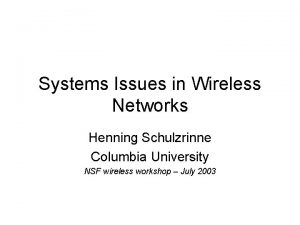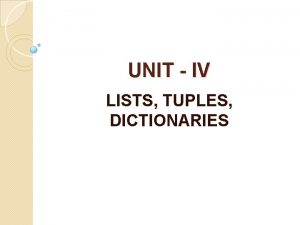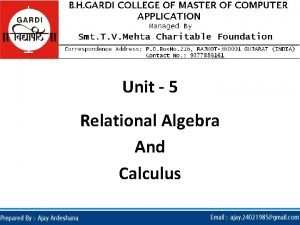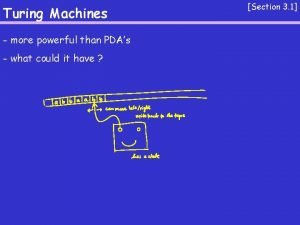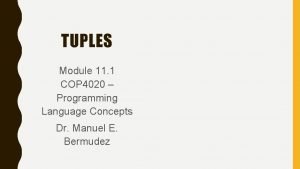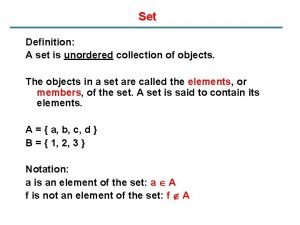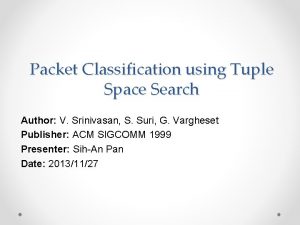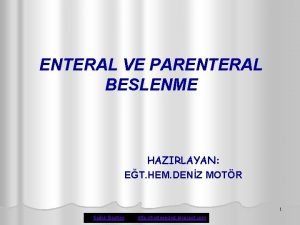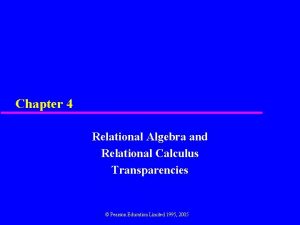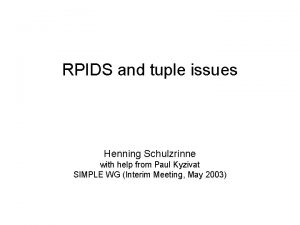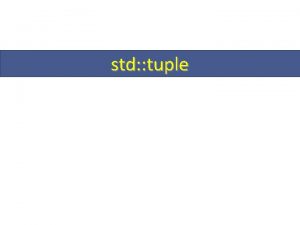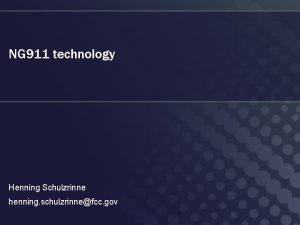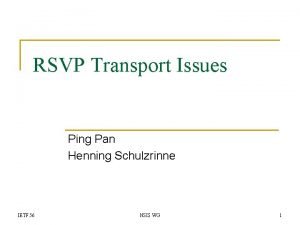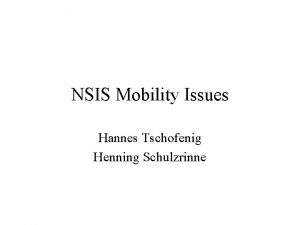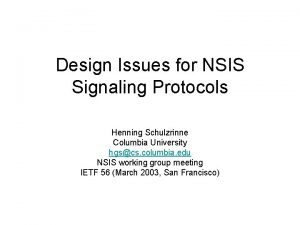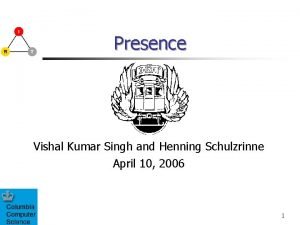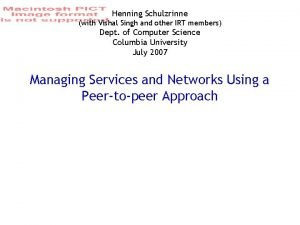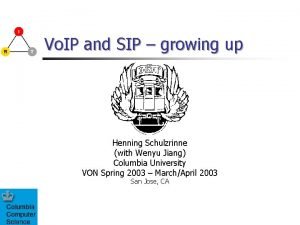RPIDS and tuple issues Henning Schulzrinne with help












- Slides: 12

RPIDS and tuple issues Henning Schulzrinne with help from Paul Kyzivat SIMPLE WG (Interim Meeting, May 2003)

Open Issues • From IETF 56 SIMPLE minutes: – RPIDS as successor to PIDF? – tuple semantics – labeling elements: uniqueness across time, space, … • Mailing list discussion

Step back: what do we want presence to support? • General notion of reachability for communications • Generally, device-mediated • Also, direct human-human communication (drop in and chat) • Later, maybe status (“X is travelling, so no point in waiting for her to start the meeting”)

How does the system work? • RPIDS document (? ) should spell out at least one scenario presence notification u 1: p 1, p 2|p 3 u 2: p 1, p 4 u 3: p 5, p 6 caller INVITE u 1 Want: p 1, p 2, p 9 p 1 u 1 or u 2 p 1+p 2 u 1 p 5, p 5 u 3 callee

Open issues – what is a tuple? • Three models have been proposed: 1. All share same AOR (e. g. , sip: alice@example. com); selection via CP • 2. Custom-generated address for each capability set (maybe several for each device); e. g. , sip: x 45 tyu 7@example. com • • 3. longevity of address? tight relationship with proxy server Contact addresses representing devices; e. g. , tel: +1 -555123 -4567, sip: ph 17@alice-employer. com • • • availability of caller preferences privacy how long is address valid? (watcher address book) Not necessarily mutually exclusive – need all of them

Tuple semantics • Tuple represents opaque entity, e. g. , a group – easy, since few characteristics except “this is a group” – intersection or union probably makes little sense • Tuple represents media capability – “reachable by audio” – may be implemented by multiple devices • Tuple represents device (or location) – may become more important as location information increases – can be represented either by host or user part: • direct contact (sip: alice@128. 59. 16. 1) • unique label (sip: alice+4867@columbia. edu)

Tuple semantics home office mobile audio video text yes no yes, but low quality yes can, but inappropriate now can’t preferred • But really N-dimensional hypercube: – arrange by ‘category’, ‘placetype’, ‘privacy’, … • Thus, can’t hope to represent as anything but enumeration • While number of descriptors is large and will grow, number of instances represented is likely to remain smallish (~3 -5? ) – mobile multi-function devices make smaller number of devices seem likely

Tuple perspectives • hide details of user devices (and maybe location or other aspects) – sometimes, address could be used to guess user location or behavior (aol. com home, mobile device traveling) – not all users will have the ability to create injective (1 -1) identities – want centralized policy enforcement point for simplicity – focus on callee control • provide details – description insufficient for informed caller choice – emphasis on caller empowerment

Anonymous tuples • Tuples without contact • Current meaning: face-to-face communications • Needed since presentity URI may not be usable by communications application (e. g. , pres: ) • May also become useful for presence focused on activity – e. g. , track where rescue worker (soldier, nurse, Maytag repairman, …) is and environmental characteristics (heart rate, air temperature, …)

Tuple – resolution? • Hard to anticipate uses – document choices and trade-offs • UI considered solvable: – represent as enumeration or table (matrix) with properties in either case – use <note> to provide hints • Can’t rely on caller preferences for the near future – should we require support on caller side for disambiguation? (Opinion: policy issue)

Open issues - label • PIDF defines "id" tuple tag – allows to replace changed tuples without sending all the unchanged ones – not clear from spec who modifies (PA? ) and what its lifetime is • Separate "label" tag proposed – similar semantics, but set by presentity and left alone by PA – for policy filtering ("only show 'class=minimal' items when notifying low-bandwidth watchers") • Cf. Cascading Style Sheets (CSS): – "id" = unique across document – "class" = type of element

Proposal: Labeling • Support class parameter/label: – – – similar to <div class=X></div> semantics in HTML and CSS one-to-many: one class, many tuples each tuple can have at most one class inherited (if supported in RPIDS) used for filtering and policy • Identifier (id): – – for identification (replace, edit, delete) of specific tuples unique across all tuples for presentity should not be re-used e. g. , time of initial creation of tuple
 Henning schulzrinne
Henning schulzrinne Difference between a list and a set in python
Difference between a list and a set in python Tuple and domain calculus are collectively known as
Tuple and domain calculus are collectively known as Self help and community help is the motto of
Self help and community help is the motto of Pda is more powerful than
Pda is more powerful than Turing machine formal definition
Turing machine formal definition Prolog tuples
Prolog tuples Sets are equal
Sets are equal Tuple space search
Tuple space search Markov decision process merupakan tuple dari
Markov decision process merupakan tuple dari Periferik parenteral beslenme
Periferik parenteral beslenme Turing machine 7 tuple
Turing machine 7 tuple Relational algebra and calculus
Relational algebra and calculus
